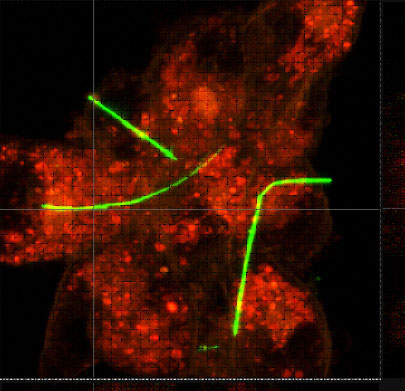| Posted: December 18, 2008 |
Better than Phelps: hot, golden, swimming nanowires zap cancer |
|
(Nanowerk News) The next big thing in cancer treatment may be hotter, covered in more gold, and even be a better swimmer than recent Olympic champion Michael Phelps.
|
|
Scientists at the University of Idaho are engineering multifunctional and dynamic nanowires coated in gold that swim through the bloodstream and attach to specific cancerous cells. Once there, an electromagnetic field heats the nanowires, which destroys the targeted cells. The research is supported by a new $425,000 grant, part of a multimillion dollar project funded by the Korean government as part of the International Global Collaboration Pioneer Program.
|
|
“Cancer is a dangerous enemy because radiation and chemical treatments cause a lot of side effects,” said Daniel Choi, associate professor of materials science and engineering at the University of Idaho and leader of the project. “We can’t avoid side effects 100 percent, but these nanowires will minimize the damage to healthy cells.”
|
 |
| This image depicts several cells coated with fluorescent dyes making them appear red. Three nanowires – the neon green lines – have successfully attached themselves to the cells. When a low frequency electromagnetic field is applied, the nanowires heat up and destroy the attached cells.
|
| The technology involves many steps requiring lots of continuing research, but each of the basic concepts already have been proven in laboratory tests.
|
|
Choi and his team have already created nanowires that can “swim” to their targets and heat up when exposed to low frequency electromagnetic fields, which are not harmful to human body. The next step is to make them biocompatible, meaning safe to introduce to the human body, and able to seek out specific cancer cells.
|
|
Choi believes the gold plating will take care of the biocompatibility. If not, he has several polymers in mind that he also believes would work.
|
|
As for seeking out specific cancer cells, Choi also is a member of and working with a University of Idaho group called BANTech – an interdisciplinary group that integrates nanomaterials research with cell biology and bioscience research. The group has identified several promising candidates for antibodies with which to coat the nanowires that would seek out and attach to specific cancer cells.
|
|
Once the technology has proven itself in the laboratory, it will be tested in live animals, and eventually human beings. Several Korean institutions, which are helping in every phase of research, will take the lead in that project. The institutions are Seoul National University, Korea University and the Korea Institute of Science and Technology.
|
|
“Collaborating with Korean institutions has been a wonderful experience full of mutual benefits and great achievements,” said Choi. “Multi-institutional, multi-national projects can provide students and researchers with opportunities to engage in cutting-edge investigations within an international research environment, which is very important to advancing science.”
|

